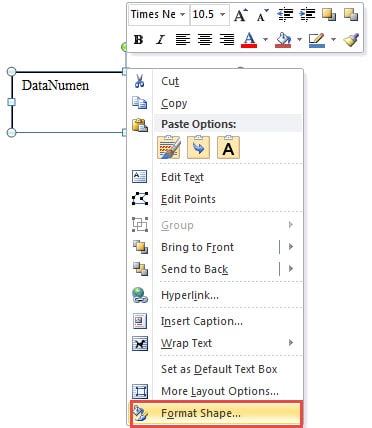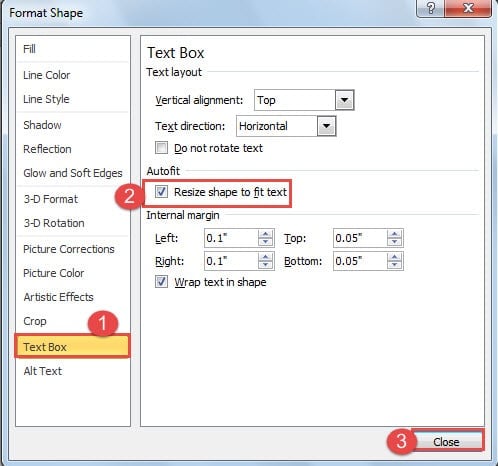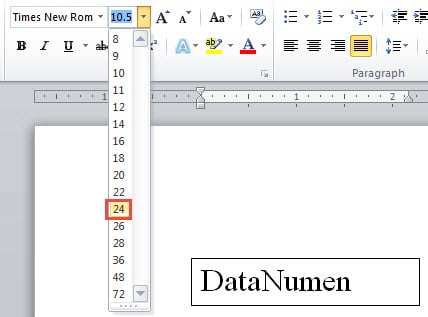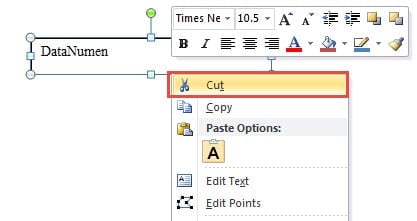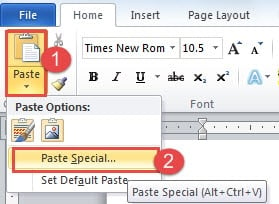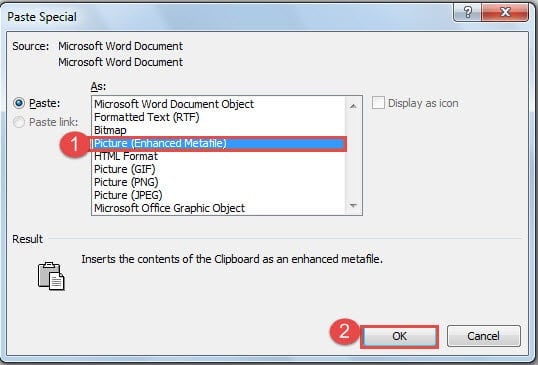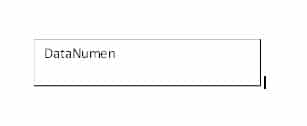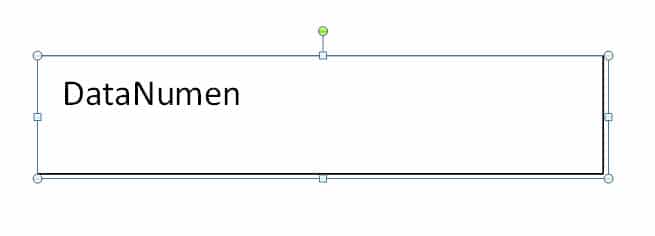Publisher for Microsoft 365 Publisher 2021 Publisher 2019 Publisher 2016 Publisher 2013 Publisher 2010 Publisher 2007 More…Less
If you type or import more text than the text box can hold, Publisher stores the extra text in overflow, where you can’t see it. Here are some ways to make the text fit into the text box.
Fit text automatically
-
Click anywhere in the text.
-
On the Text Box Tools Format tab, in the Text group, click Text Fit, and do one of the following:
-
To reduce the point size of text until there is no text in overflow, click Shrink Text On Overflow.
-
To shrink or expand text to fit in the text box when you resize the box, click Best Fit.
-
Fit text manually
Here are some ways to fit text in a text box manually:
-
Change the size or font of the text.
-
Delete text.
-
Increase the size of the text box.
-
Reduce the line spacing.
How?
-
On the Home tab, click the Paragraph dialog box launcher
, and then click the Indents and Spacing tab.
-
Under Line spacing, select the options that you want.
-
-
Adjust the spacing between all characters (tracking).
How?
-
Select the paragraphs you want to change.
-
On the Text Box Tools Format tab, in the Font group, click Character Spacing
, and then click More Spacing.
-
In the Character Spacing dialog box, under Tracking, do one of the following:
-
To adjust tracking automatically, click one of the preset spacing options.
-
To adjust tracking manually, click Custom, and then enter a percentage between 0.1% and 600% in the By this amount box.
Note: Tracking is available only if you are working on a print publication.
-
-
-
Reduce the size of the text box margin.
How?
-
Right-click the text box, and then click Format Text Box.
-
On the Text Box tab, under Text Box Margins, enter the settings for the margins.
-
-
Flow text into another text box.
How?
When you connect text boxes, text that won’t fit into the first text box flows into the next text box. A chain of connected text boxes, also known as a story, can span multiple pages.
Use connected boxes to continue a story in another text box, create columns of different widths, or move text from overflow into another box.
-
Click in the text box you want as the first text box in the story.
-
On the Text Box Tools Format tab, in the Linking group, click Create Link.
The mouse pointer changes to a pitcher
.
-
Click in the text box you want as the next in the story.
This text box is now connected to the first box and any text in overflow now appears in the next box.
-
To connect more text boxes to the story, repeat these steps.
-
Fit text automatically
-
Click anywhere in the text.
-
On the Format menu, point to AutoFit Text, and do one of the following:
-
To reduce the point size of text until there is no text in overflow, click Shrink Text On Overflow.
-
To shrink or expand text to fit in the text box when you resize the box, click Best Fit.
-
Fit text manually
Here are some ways to fit text in a text box manually:
-
Change the size or font of the text.
-
Delete text.
-
Increase the size of the text box.
-
Reduce the line spacing.
How?
-
On the Format menu, click Paragraph, and then click the Indents and Spacing tab.
-
Under Line spacing, select the options that you want.
-
-
Adjust the spacing between all characters (tracking).
How?
-
Select the paragraphs you want to change.
-
On the Format menu, click Character Spacing.
-
In the Character Spacing dialog box, under Tracking, do one of the following:
-
To adjust tracking automatically, click one of the preset spacing options.
-
To adjust tracking manually, click Custom, and then enter a percentage between 0.1% and 600% in the By this amount box.
Note: Tracking is available only if you are working on a print publication.
-
-
-
Reduce the size of the text box margin.
How?
-
Select the text box.
-
On the Format menu, click Text Box.
-
In the Format Text Box dialog box, click the Text Box tab.
-
Under Text Box Margins, enter the settings for the margins.
-
-
Flow text into another text box.
How?
When you connect text boxes, text that won’t fit into the first text box flows into the next text box. A chain of connected text boxes, also known as a story, can span multiple pages.
Use connected boxes to continue a story in another text box, create columns of different widths, or move text from overflow into another box.
-
Click in the text box you want as the first text box in the story.
-
On the Connect Text Boxes toolbar, click Create Text Box Link
.
The mouse pointer changes to a pitcher
.
-
Click in the text box you want as the next in the story.
This text box is now connected to the first box and any text in overflow now appears in the next box.
-
To connect more text boxes to the story, repeat these steps.
-
Need more help?
Want more options?
Explore subscription benefits, browse training courses, learn how to secure your device, and more.
Communities help you ask and answer questions, give feedback, and hear from experts with rich knowledge.
Fit text in a text box
If you type or import more text than the text box can hold, Publisher stores the extra text in overflow, where you can’t see it. Here are some ways to make the text fit into the text box.
Fit text automatically
-
Click anywhere in the text.
-
On the Text Box Tools Format tab, in the Text group, click Text Fit, and do one of the following:
-
To reduce the point size of text until there is no text in overflow, click Shrink Text On Overflow.
-
To shrink or expand text to fit in the text box when you resize the box, click Best Fit.
-
Fit text manually
Here are some ways to fit text in a text box manually:
-
Change the size or font of the text.
-
Delete text.
-
Increase the size of the text box.
-
Reduce the line spacing.
How?
-
On the Home tab, click the Paragraph dialog box launcher
, and then click the Indents and Spacing tab.
-
Under Line spacing, select the options that you want.
-
-
Adjust the spacing between all characters (tracking).
How?
-
Select the paragraphs you want to change.
-
On the Text Box Tools Format tab, in the Font group, click Character Spacing
, and then click More Spacing.
-
In the Character Spacing dialog box, under Tracking, do one of the following:
-
To adjust tracking automatically, click one of the preset spacing options.
-
To adjust tracking manually, click Custom, and then enter a percentage between 0.1% and 600% in the By this amount box.
Note: Tracking is available only if you are working on a print publication.
-
-
-
Reduce the size of the text box margin.
How?
-
Right-click the text box, and then click Format Text Box.
-
On the Text Box tab, under Text Box Margins, enter the settings for the margins.
-
-
Flow text into another text box.
How?
When you connect text boxes, text that won’t fit into the first text box flows into the next text box. A chain of connected text boxes, also known as a story, can span multiple pages.
Use connected boxes to continue a story in another text box, create columns of different widths, or move text from overflow into another box.
-
Click in the text box you want as the first text box in the story.
-
On the Text Box Tools Format tab, in the Linking group, click Create Link.
The mouse pointer changes to a pitcher
.
-
Click in the text box you want as the next in the story.
This text box is now connected to the first box and any text in overflow now appears in the next box.
-
To connect more text boxes to the story, repeat these steps.
-
Fit text automatically
-
Click anywhere in the text.
-
On the Format menu, point to AutoFit Text, and do one of the following:
-
To reduce the point size of text until there is no text in overflow, click Shrink Text On Overflow.
-
To shrink or expand text to fit in the text box when you resize the box, click Best Fit.
-
Fit text manually
Here are some ways to fit text in a text box manually:
-
Change the size or font of the text.
-
Delete text.
-
Increase the size of the text box.
-
Reduce the line spacing.
How?
-
On the Format menu, click Paragraph, and then click the Indents and Spacing tab.
-
Under Line spacing, select the options that you want.
-
-
Adjust the spacing between all characters (tracking).
How?
-
Select the paragraphs you want to change.
-
On the Format menu, click Character Spacing.
-
In the Character Spacing dialog box, under Tracking, do one of the following:
-
To adjust tracking automatically, click one of the preset spacing options.
-
To adjust tracking manually, click Custom, and then enter a percentage between 0.1% and 600% in the By this amount box.
Note: Tracking is available only if you are working on a print publication.
-
-
-
Reduce the size of the text box margin.
How?
-
Select the text box.
-
On the Format menu, click Text Box.
-
In the Format Text Box dialog box, click the Text Box tab.
-
Under Text Box Margins, enter the settings for the margins.
-
-
Flow text into another text box.
How?
When you connect text boxes, text that won’t fit into the first text box flows into the next text box. A chain of connected text boxes, also known as a story, can span multiple pages.
Use connected boxes to continue a story in another text box, create columns of different widths, or move text from overflow into another box.
-
Click in the text box you want as the first text box in the story.
-
On the Connect Text Boxes toolbar, click Create Text Box Link
.
The mouse pointer changes to a pitcher
.
-
Click in the text box you want as the next in the story.
This text box is now connected to the first box and any text in overflow now appears in the next box.
-
To connect more text boxes to the story, repeat these steps.
-
Written by Allen Wyatt (last updated July 17, 2021)
This tip applies to Word 2007, 2010, 2013, 2016, 2019, and Word in Microsoft 365
Steve routinely adds a good number of text boxes to his documents. Every time he does, he needs to display the Format Shape pane and choose the Resize Shape to Fit Text check box. Steve wonders if there is a way to make this setting the default. He can’t imagine why anyone would not want to have text boxes automatically resize to fit whatever text they contain.
An easy way to handle this is to change how you actually create your text box. If you create an empty text box, Word automatically clears the Resize Shape to Fit Text check box and you will need to change it. (This is what Steve is seeing.) Instead, follow these simple steps:
- Type the text you want in your text box.
- Select the text you just typed.
- Display the Insert tab of the ribbon.
- Click the Text Box tool. Word displays a few options.
- Choose the Draw Text Box option.
Since you had text selected (step 2), Word places a text box around the selected text and, in the Format Shape pane, you’ll note that the Resize Shape to Fit Text check box is selected. Thus, even if you edit the text in the text box, the text box will resize to fit whatever text it contains.
This presents an interesting variation—if you don’t know, immediately, what text you want in the text box, you could (in step 1) type a single word or even a single character. Then, when you decide what you want in the text box, you can edit the contents and, since the Resize Shape to Fit Text check box is selected, the text box resizes to accommodate your text.
WordTips is your source for cost-effective Microsoft Word training.
(Microsoft Word is the most popular word processing software in the world.)
This tip (13883) applies to Microsoft Word 2007, 2010, 2013, 2016, 2019, and Word in Microsoft 365.
Author Bio
With more than 50 non-fiction books and numerous magazine articles to his credit, Allen Wyatt is an internationally recognized author. He is president of Sharon Parq Associates, a computer and publishing services company. Learn more about Allen…
MORE FROM ALLEN
Getting Audible Feedback
You can add a bit of sound to your editing tasks by turning on Word’s sound capabilities. This tip shows where this …
Discover More
Using R1C1 Formula References in a Macro
Besides the regular way of displaying formulas, Excel can also display them using what is called R1C1 format. If you are …
Discover More
Entering Numbers in Excel
Enter information into a cell, and Excel needs to figure out what type of information it is. Here’s how Excel interprets …
Discover More
In this article, we are going to introduce you 2 methods to match the text box size with the inside text size in your Word.
There and then you must have inserted text box into your Word document. However the problem remains there is that when you drag the text box to enlarge or narrow its size, the size of the text within does not change accordingly. What an ailing issue! As usual, we are here to relieve you from the big headache.
As a matter of fact, it’s not a rocket science to address the problem. Following are two methods you can employ in your Word file.
Method 1: Make Text Box Size Fit Text
- First and foremost, click “Insert”.
- Then go to click “Text Box” in “Text” group.
- Next enter your text into the box.
- Then click one of the text box lines to select the textbox.
- Next right click.
- Go to choose “Format Shape” option on the list-menu.
- Now in “Format Shape” dialog box, you first click “Text Box” option on the left side column.
- Then on the right side area, check “Resize shape to fit text” box under “Autofit”.
- Next click “Close” button.
Only when you check “Resize shape to fit text” box, can you adjust your text size without worrying the text box size failing to fit it.
- Now, you can select the text.
- Then click “Home” tab.
- Next choose a font size for the text. You will see the text box changes according to the font size.
Method 2: Convert Text Box to a Picture
- First thing is to repeat the first 5 steps in method 1.
- This time you choose “Cut” option on the list-menu. Or you can simply press “Ctrl+ X” in this step.
- Next, click “Home” tab.
- Then click the upside-down triangle on “Paste” icon in “Clipboard” group.
- And click “Paste Special” option.
- Now in “Paste Special” dialog box, click “Picture (Enhanced Metafile)”.
- Then click “OK”.
You will see the text box has been converted to a picture.
- Go to click the picture and the handles will show.
- Click one of the handles and drag to enlarge the picture. Then you find the text seems larger.
But you have to understand that the size of the text actually does not change. When you enlarge the picture, you only zoom in the text.
Comparison of 2 Methods
| Methods | Advantages | Disadvantages |
| Make Text Box Size Fit Text | 1. The text size does change.
2. You don’t have to worry that the text will outsize the text box. 3. You can edit text all the time. 4. The text display effect will not get undermined. |
1. You have to manually resize the text.
2. You have to check “Resize shape to fit text” box in “Format Shape” first. Otherwise the text may outsize the text box. |
| Convert Text Box to a Picture | The text will be larger as you enlarge the picture, so you don’t have to adjust it manually. | 1. You cannot edit the text once you convert it to picture.
2. The text display effect will get undermined. 3. The text size actually does not change. |
Quickly Retrieve Word Files
Most of us will be panic if our files get corrupt. True. File damage is definitely a serious data disaster in nowadays. Even so there is still a remedy for you that is to get a professional Word repair tool to restore your files as soon as possible.
Author Introduction:
Vera Chen is a data recovery expert in DataNumen, Inc., which is the world leader in data recovery technologies, including tools to repair Excel and pdf repair software products. For more information visit www.datanumen.com
-
1
Click the Insert tab.
-
2
On the right side of all of the things you can insert, look for ‘Text Box.’
Advertisement
-
3
Select the text box that you want to use and double click on it.
-
4
Cut and paste the text into the text box.
Advertisement
Ask a Question
200 characters left
Include your email address to get a message when this question is answered.
Submit
Advertisement
Video
-
To change the size of the text box, click on it once, and drag one of the 8 circles.
-
You can change the design of the text box you have selected by going into the format tab.
Thanks for submitting a tip for review!
Advertisement
About This Article
Thanks to all authors for creating a page that has been read 98,464 times.
Is this article up to date?
wikiHow Tech Help Pro:
Level up your tech skills and stay ahead of the curve
Let’s go!

 , and then click the Indents and Spacing tab.
, and then click the Indents and Spacing tab. , and then click More Spacing.
, and then click More Spacing. .
. .
.
